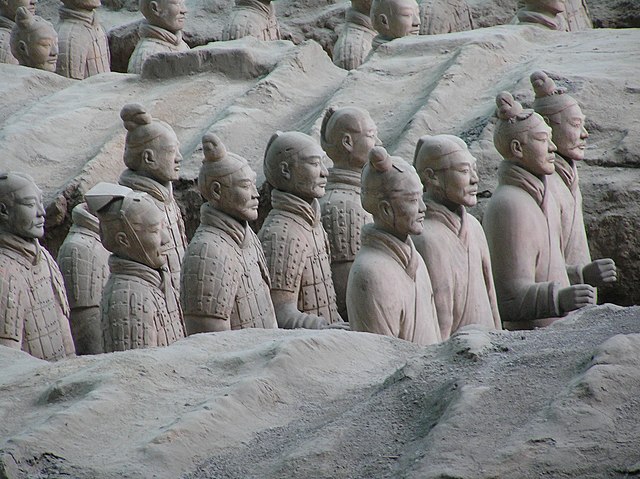History of the Han dynasty
The Han dynasty was the second imperial dynasty of China. It followed the Qin dynasty, which had unified the Warring States of China by conquest. It was founded by Liu Bang. The dynasty is divided into two periods: the Western Han and the Eastern Han, interrupted briefly by the Xin dynasty of Wang Mang. These appellations are derived from the locations of the capital cities Chang'an and Luoyang, respectively. The third and final capital of the dynasty was Xuchang, where the court moved in 196 CE during a period of political turmoil and civil war.
Qin dynasty soldiers from the Terracotta Army of Qin Shi Huang's mausoleum, located near Xi'an
A Western Han bronze wine warmer with cast and incised decoration, from Shanxi or Henan province, 1st century BCE
A gilded belt clasp with turquoise, dated Warring States period to early Han dynasty, 4th to 3rd centuries BCE
Beginning in the Han period, kings were interred in jade burial suit made of small pieces of jade sewn together with golden thread. (金縷玉衣)
The Han dynasty was an imperial dynasty of China, established by Liu Bang and ruled by the House of Liu. The dynasty was preceded by the short-lived Qin dynasty (221–206 BC) and a warring interregnum known as the Chu–Han contention (206–202 BC), and it was succeeded by the Three Kingdoms period (220–280 AD). The dynasty was briefly interrupted by the Xin dynasty (9–23 AD) established by the usurping regent Wang Mang, and is thus separated into two periods—the Western Han and the Eastern Han (25–220 AD). Spanning over four centuries, the Han dynasty is considered a golden age in Chinese history, and had a permanent impact on Chinese identity in later periods. The majority ethnic group of modern China refer to themselves as the "Han people" or "Han Chinese". The spoken Sinitic language and written Chinese are referred to respectively as the "Han language" and "Han characters".
Western Han painted ceramic jar with raised reliefs of dragons, phoenixes, and taotie
Reverse side of a Western Han bronze mirror with a painted flower motif
Statue of a horse trampling a Xiongnu warrior, at the mausoleum of Western Han general Huo Qubing (d. 117 BC), who fought in the Han–Xiongnu War. This is the first known monumental stone statue in China.
The ruins of a Han-dynasty watchtower made of rammed earth at Dunhuang, located at the eastern edge of the Silk Road








